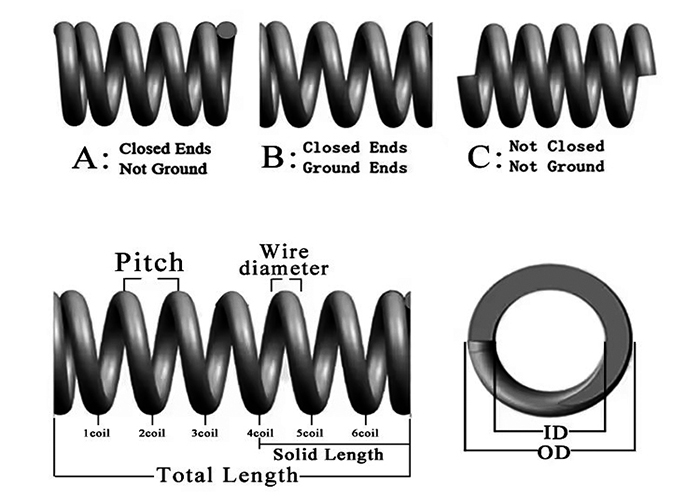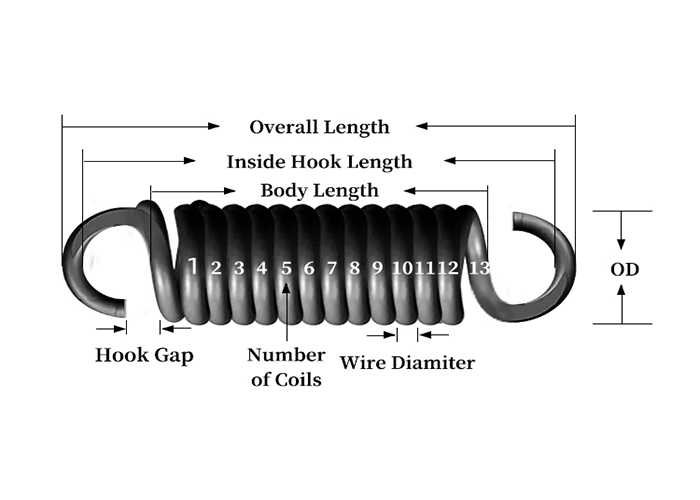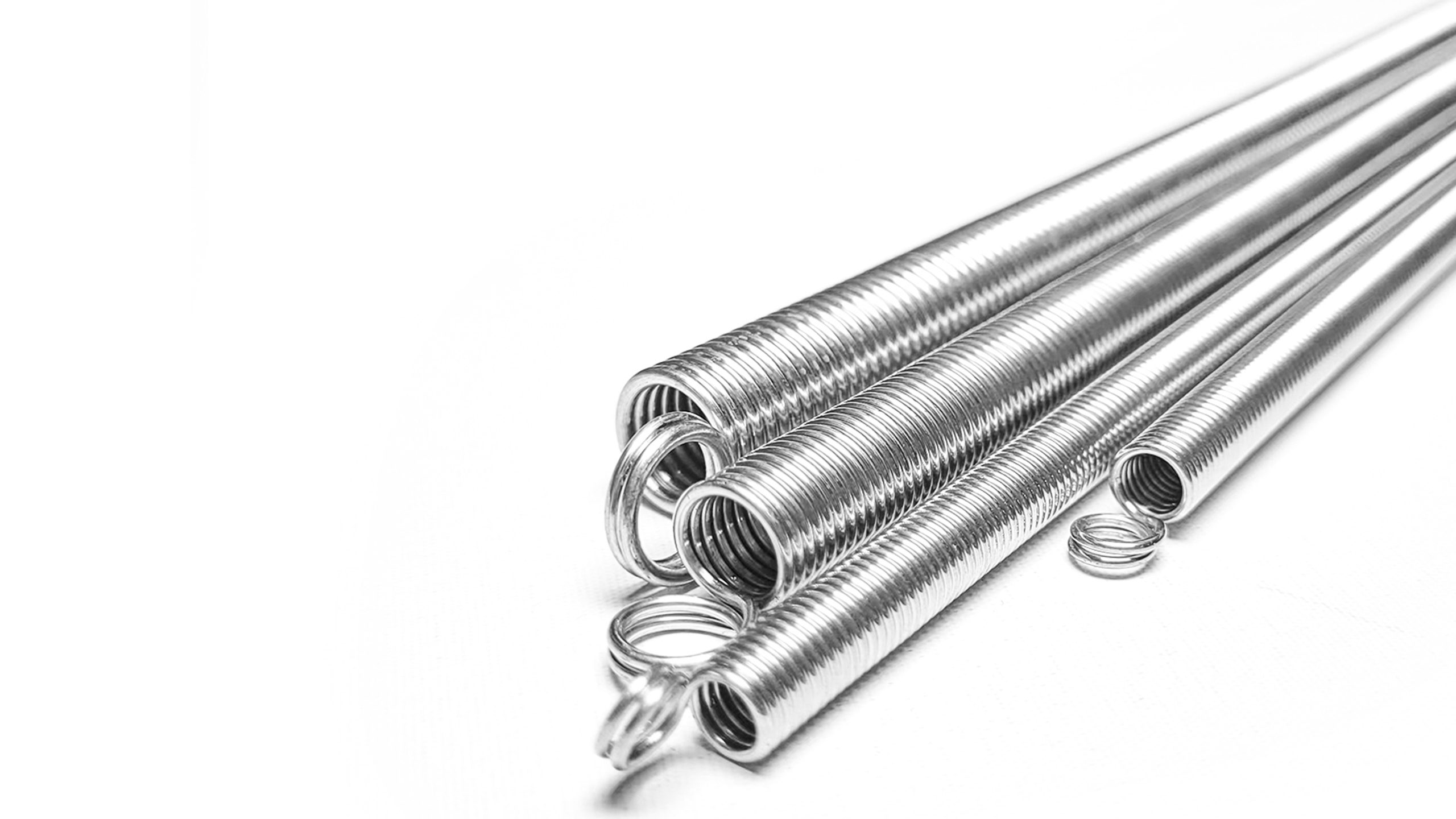Our engineers are trained to use cutting-edge techniques to craft tension spring for exceptional performance,durability,reliability,and cost-effectiveness.We also offer a wide range of tension spring sizes,and materials,allowing us to tailor our products to the unique needs of our customers.
Specifiche dell'acciaio al carbonio: MK-65MN-TCS01 、 MK-65MN-TCS02、 MK-65MN-TCS03、 MK-65MN-TCS04、 MK-65MN-TCS05、 MK-65MN-TCS06、 MK-65MN-TCS07、 MK-65MN-TS08、 MK-65MN-TCS09
Specifiche dell'acciaio inossidabile 304:MK-304SS-TCS01 、MK-304SS-TCS02 、MK-304SS-TCS03 、MK-304SS-TCS04 、MK-304SS-TCS05、MK-304SS-TCS06、MK-304SS-TCS07、MK-304SS-TCS08
Hook-end extension springs are commonly used in various mechanical devices, particularly in scenarios where precise movement control or tension is required.
Hook-end extension springs are used to control the opening and closing of doors or to maintain the tension and position of certain components.
It provides elastic tension, allowing users to stretch and release for exercise or entertainment purposes.
Hook-end extension springs are used to keep doors and windows tightly closed or to control the opening angle. They also provide a gentle closing force to prevent the door from slamming shut.
Used to ensure stability of the equipment during operation or provide the necessary tension.



Abbiamo la capacità di fornire ai nostri clienti molle di compressione personalizzate per soddisfare quasi tutte le specifiche

Your customers demand the highest quality springs for maximum load capacity and at Makeway Spring we have the springs you need. Our commitment to the highest quality spring for your application starts with the spring stock and doesn’t end until we pack and ship the last coil to complete your order.
Test sui materiali:
We monitor every lot of wire material that is submitted for testing and prototyping to ensure the highest quality product.
Precisione dimensionale:
This involves measuring critical dimensions of the extension spring, such as wire diameter, outer diameter, length, and the number of active coils. This ensures that the spring conforms to your specified design requirements.
Load Testing:
This test involves subjecting the extension spring to various loads to verify that it can extend and retract without any deformation or failure. The load should be applied gradually to prevent sudden overloading
Elasticity and Stress Testing:
This test evaluates how well the spring returns to its original shape after being stretched. It measures factors like modulus of elasticity and yield strength to ensure the spring can handle the expected loads.
Test di fatica:
Extension springs are often subjected to repeated cycles of loading and unloading. Fatigue testing simulates these conditions to ensure the spring can withstand the anticipated number of cycles without failure
Load Testing:
This involves applying a load to the spring and measuring the corresponding deflection. This helps characterize the spring’s behavior under different loads.
Visual Inspection:
A visual examination of the spring is crucial to identify any surface defects, such as cracks, pitting, or other anomalies.

Tension springs store energy and resist pulling forces by elongating under load and returning to their original length. Typically made of stainless steel for durability and corrosion resistance, they’re vital in mechanical systems.
When selecting an extension spring with hooks, consider the following:
The tension an extension spring can handle depends on its material,wire diameter,number of coils,and design.Different specifications of extension springs are suited for various loads and applications.Manufacturers typically provide the maximum load specifications to ensure safe use.
The lifespan of an extension spring depends on factors such as usage frequency,applied tension,material,and environmental conditions.High-quality materials and proper surface treatments can extend the life of the spring.
Yes,if made from stainless steel or treated for corrosion resistance (e.g.,galvanized or coated),extension springs with hooks are suitable for outdoor or humid environments and can maintain performance for long period
End treatment plays a crucial role in the functionality and durability of extension springs.Common methods include closed and ground ends,open ends with hooks or loops,or other specialized configurations.Proper finishing,such as shot peening or coating,can enhance corrosion resistance and surface quality.
Quality control is paramount in extension spring manufacturing.This includes dimensional inspections,load testing,stress and elasticity testing,material analysis,and visual inspections.Additionally, following relevant industry standards and adhering to specific customer requirements is crucial for producing reliable and consistent springs.
Dalla progettazione iniziale della molla alla produzione e alla consegna, le nostre best practice e il nostro controllo qualità garantiscono la consegna di componenti precisi e realizzati appositamente per il tuo progetto. Ogni soluzione è progettata per le tue esigenze.

Le molle a compressione sono un tipo comune di molla progettata per resistere alle forze di compressione. Queste molle sono tipicamente avvolte e sono ampiamente utilizzate in applicazioni come sospensioni automobilistiche, macchinari industriali e dispositivi elettronici.

Le molle per stampi sono progettate per applicazioni ad alto carico e sono comunemente utilizzate negli stampi per stampaggio e nei set di stampi. Queste molle sono solitamente realizzate in acciaio legato ad alta resistenza, che offre una maggiore resistenza alla compressione e una maggiore durata.

Le molle di trazione immagazzinano energia quando vengono allungate e tornano alla loro forma originale quando vengono rilasciate. Sono comunemente utilizzate in applicazioni come serrature, giocattoli e dispositivi meccanici. Le molle di trazione in genere presentano ganci su entrambe le estremità per il fissaggio.

Le molle di trazione senza testa sono simili alle molle di trazione tradizionali, ma sono prive di ganci o estremità tradizionali. Queste molle vengono utilizzate in applicazioni che richiedono metodi di fissaggio specifici per soddisfare i requisiti di progettazione.

Le molle degli orologi, note anche come molle principali, sono molle a spirale utilizzate per accumulare energia meccanica. Sono ampiamente utilizzate in orologi, giocattoli e altri dispositivi che richiedono un accumulo di energia. Queste molle possono essere caricate manualmente o meccanicamente e quindi rilasciare energia per alimentare dispositivi meccanici.

Le molle di torsione sono progettate per resistere alla coppia o alla forza rotazionale. Queste molle sono comunemente utilizzate in clip, interruttori, porte da garage e altri dispositivi in cui viene applicata una forza rotazionale, fornendo una forza di contrasto tramite torsione.

Le molle in ottone sono realizzate in ottone, materiale che offre un'eccellente resistenza alla corrosione e conduttività elettrica. Sono spesso utilizzate in applicazioni che richiedono resistenza alla corrosione o conduttività elettrica, come interruttori e terminali elettrici.

La formatura del filo comprende varie molle e parti realizzate piegando il filo metallico in forme specifiche. Sono progettate su misura per applicazioni specifiche e possono essere realizzate in forme complesse per adattarsi a dispositivi meccanici o elettronici specifici.
Ottieni preventivi e informazioni sui prodotti di prima mano: siamo disponibili 24 ore su 24, 7 giorni su 7 per rispondere a qualsiasi tua richiesta.
info@makeway-llc.com
+86 755 28459980
Stanza 1510, Edificio 13 Huanancheng, n. 1 Ping'an Avenue, distretto di Longgang, Shenzhen, Guangdong, Cina